Mathematics is an indispensable tool for understanding and solving many of the problems of everyday life, it forms the formal language for many disciplines and defines a science, with its methods and laws, to which genuine research is associated. The Mathematics Department has sought to reconcile these aspects by specializing in applied mathematics since its inception, in both teaching and research.
The Department of Mathematics is located in the Sciences-Arrupe building, occupying a wing on the third and fourth floors.
It is responsible for undergraduate, master's and doctoral courses in mathematics. It also teaches in other sections and faculties.
Spotlight
News
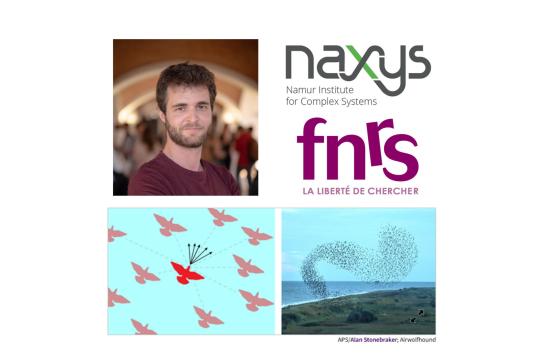
Two prestigious publications for our network dynamics researchers
Two prestigious publications for our network dynamics researchers
Maxime Lucas is an FNRS Research Fellow in the Department of Mathematics and a member of the naXys Institute. He works on complex systems within the "Network Dynamics" cluster headed by Professor Timoteo Carletti. He is co-author of two papers on complex systems, recently published in prestigious journals Nature Physics and Physical Reviews Letters.

Analysis of collective behavior in complex systems
The study of complex systems published in Physical Reviews Letters supports a growing trend that focuses more on analyzing the collective behavior of a system rather than discovering the underlying mechanisms of interaction.
When we observe a flock of starlings swirling through the sky in perfect coordination - a phenomenon known as murmuration - we witness the elegant interplay of individual actions creating collective behavior. In trying to understand these fascinating patterns, researchers can isolate simple rules based on an individual bird's field of view and the distance separating it from its neighbors, but there's always the question of whether the model actually captures the processes driving interactions between birds (Fig. 1).
This is a general problem in complex systems research, which comes down to distinguishing mechanisms (the rules governing interactions) from behaviors (the observable patterns that emerge).
Figure 1: In bird flocks, each bird chooses its movement according to the separation distance and flight orientation of its neighbors (left). These simple rules can produce complex patterns, such as starling "murmurations" (right). New research explores how mechanisms (individual rules) are linked to behaviors (collective patterns) in networks that represent complex systems.
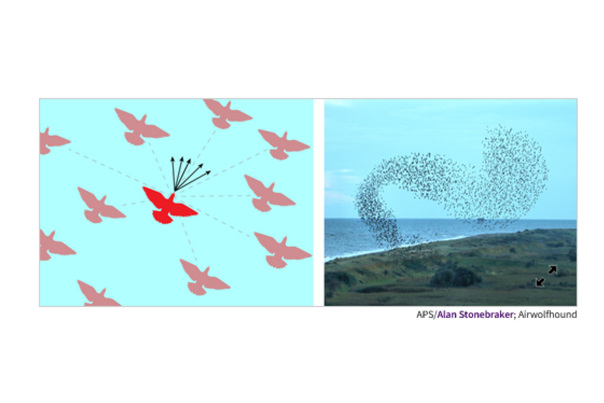
Representative networks of interacting individuals, or nodes, are a good way to study mechanisms versus behaviors. Until now, researchers have focused on pairwise interactions, but many systems also include higher-order interactions between several nodes. The impact of these higher-order mechanisms on behavior has not been clearly established. Thomas Robiglio, from the Central European University in Vienna, and his colleagues, including Maxime Lucas (CR FNRS - UNamur) addressed this question. They considered networks with higher-order interactions and evaluated the resulting behaviors in terms of statistical dependencies between node values.
The researchers identified higher-order behavioral signatures which, unlike their pairwise counterparts, reveal the presence of higher-order mechanisms. Their findings open up new avenues for distinguishing mechanisms and behaviors when studying complex systems - a distinction that is crucial for the study of inference in network science, neuroscience, the social sciences and beyond.
This study is also the subject of a "Featured in Physics" and "Editor's suggestion" article, and a "commentary" article at the journal's request, available on their website in English in full.
Namur Institute for Complex Systems (naXys)
The naXys institute specializes in the analysis of complex systems, whether in astronomy and dynamic cosmology, mathematical biology, optimization in optics, economic complexity or the study of the stability and robustness of these systems.

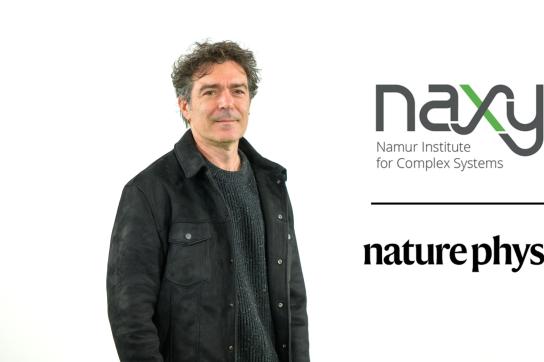
UNamur researchers published in Nature Physics
UNamur researchers published in Nature Physics
Professor Timoteo Carletti of the University of Namur has just published in the prestigious journal Nature Physics in collaboration with Professor Ginestra Bianconi of Queen Mary University of London and eight other international researchers. This groundbreaking study could lead to the development of new AI algorithms, new ways of studying brain function, or breakthroughs in disciplines such as physics, climate science, finance and many others.
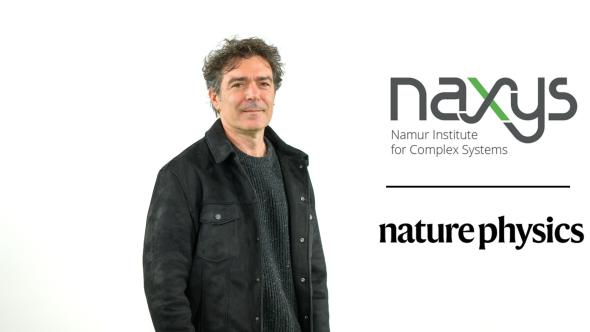
The study, entitled "Topology shapes dynamics of higher-order networks" proposes a theoretical framework specifically designed to understand complex higher-order networks where several agents interact at the same time and thus generalize networks with their interactions in pairs. More precisely, the study shows how topology shapes dynamics, how dynamics learns topology and how topology evolves dynamically.
The aim of this work is to introduce physicists, mathematicians, computer scientists and network scientists to this emerging research field, as well as to define future research challenges where discrete topology and nonlinear dynamics mix.
With the data in their possession, the researchers show that real-life complex systems such as the brain, chemical reactions and neural networks can be easily modeled as higher-order networks, characterized by multi-body connections indicating the fact that several elements of the system interact simultaneously.
This international team is convinced that the visibility of their work through this publication in Nature Physics will open the door to new collaborations with other disciplines that rely on network analysis to study real complex systems.
Kudos to the team for this publication!
Timoteo Carletti - Mini CV
After a Master's degree in physics (University of Florence, June 1995), Timoteo Carletti pursued his doctoral studies in Florence (Italy) and Paris (France) at IMCCE, finally defending his doctoral thesis in mathematics in February 2000.
He moved to Belgium in 2005, and was hired at the University of Namur as a lecturer, then as a professor (2008), and finally as a full professor (2011) in the Mathematics Department of the Faculty of Science. In 2010, he was one of the founders of the Namur Center for Complex Systems (now the Namur Institute for Complex Systems - naXys), which he headed until December 2014.
.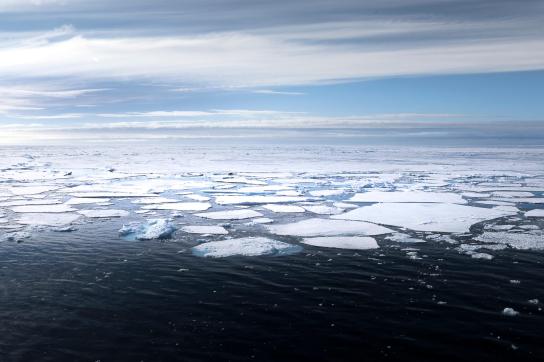
Better prediction of climate extremes
Better prediction of climate extremes
Statistics usually focus on anticipating events that fall within the norm. But what about rare events? They are dealt with by a branch of mathematics called extreme value theory, in which Anna Kiriliouk, lecturer in statistics at UNamur, is a specialist. Applied to the climate, this theory enables us to better predict extreme climatic events, at a time when these are multiplying due to climate change.
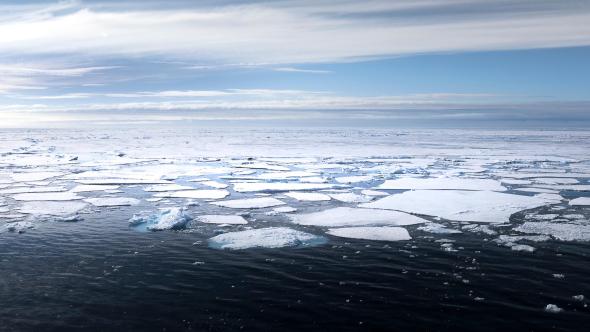
This article is taken from the "Impact" section of the December 2024 issue of Omalius magazine.
On the night of January 31, 1953, the North Sea suddenly rose by almost four meters, submerging parts of the Netherlands and Belgium. The disaster caused the death of over 2,500 people, as well as considerable damage. According to Anna Kiriliouk, lecturer in statistics at UNamur's Department of Mathematics and EMCP Faculty, this exceptional event truly marked "the beginning of the development of extreme value theory, with the development of the first extreme value construction project"
The Delta Plan, as it is called, is a system of dikes that protects the Netherlands against the risk of flooding, with these dikes overtopping once every 10,000 years. A rare danger, certainly, but not zero, which "could not have been calculated using conventional statistics, which are very poorly adapted to rare events", believes the mathematician.
While climate change is often discussed in terms of averages, such as rising temperatures and sea levels, it also has the consequence of increasing the frequency of extreme weather events, with significant repercussions for our societies. "In other words, the risk increases along with the concentration of greenhouse gases (GHGs) in the atmosphere", summarizes the researcher. "Thus, a flood calculated in 1953 to occur only every 10,000 years does not have the same significance as today. The latter could happen more frequently, for example every 1,000 years."
Attributing extreme events
While extreme weather events are on the increase, it's difficult in practice to attribute any particular flood or drought to climate change. With this in mind, Anna Kiriliouk has just been awarded an interdisciplinary research project,named EXALT, in collaboration with UCLouvain. "It involves both climatologists and statisticians, she reveals.

"This collaboration is very important, because answering this question of the attribution of extreme events can only be done through the development of a common language between our two disciplines, which currently operate separately. We have a lot to learn from each other"
In practice, the EXALT project will therefore calculate the probabilities of an extreme event occurring, and compare this probability with that of the same situation in a world where GHG emissions would not have increased. "Of course, we don't have real data from such a world", says Anna Kiriliouk. "We are therefore basing ourselves on alternative climate simulations, the quality of which we will moreover compare, with a focus on extreme events."
Divided into three working groups, the EXALT project will seek in particular to determine the role of climate change in the occurrence of floods, as well as heat waves and drought in Europe. And to do so as realistically as possible: "One of the things we want to incorporate into climate models concerns the dependency between data," explains Anna Kiriliouk. "For example, if a heat wave hits Namur, there's a good chance that the same temperatures will affect Louvain-La-Neuve. We therefore say that there is a strong spatial dependency between these two data. However, this dependence is probably not at all valid for rain, which is much more heterogeneous. By taking into account all these variables, both spatial and temporal, we hope to improve existing models."
A third working group will study much more distant areas, located in Antarctica. "Until 2016, the extent of the Antarctic ice pack was increasing, before abruptly decreasing", the researcher illuminates. "Or, according to the models, this event was considered almost impossible. But with one of EXALT's partners, we began to analyze the evolution of pack ice extent using extreme value theory. With the latter, this sudden drop was no longer so improbable. This gave us confidence in our approach, which is all the more important when the state of the pack ice has such a strong influence on other climate variables."
Compound events
This interaction between several climatic processes is, moreover, the subject of a second project just obtained by Anna Kiriliouk and funded by an FNRS Mandat d'Impulsion Scientifique. "The aim is to make it possible to study what we call compound events", explains the researcher. "During extreme climatic situations, we usually associate very high or low values simultaneously, such as a lack of rain and high temperature, resulting in an intense drought. But in the case of compound phenomena, we find that the combination of several variables, albeit in a moderate state, results in a severe and unusual event."
In 2017, for example, Hurricane Sandy, which struck the US coastline, is considered a compound event. While North Atlantic hurricanes usually dissipate in mid-ocean, this one coincided with onshore winds and a high tide, leading to massive flooding of New York and the surrounding area.
"In this project, we will therefore try to include more flexibility between the different variables, by introducing different degrees of dependence, the mathematician elaborates. "We're also going to try, as a second step, to group the dependencies together, in order to lighten the models, which become more and more complex as we add nuances to them. And once these models have been modified, we'll apply them to recent events to test their realism."
EXALT - ARC project (FWB)
Funded by the Wallonia-Brussels Federation (FWB), ARC projects are Concerted Research Action projects that aim to develop university or inter-university centers of excellence in basic research areas and, where possible, that carry out basic and applied research in an integrated way and aim to add economic and social value to research results.

Mandat d'impulsion scientifique (MIS) - FNRS
The aim of the funding granted is to support young permanent researchers wishing to develop a scientific unit within their academic institution in a promising field. This mandate has earned Anna Kiriliouk a fellowship from Namur Research College (NARC).
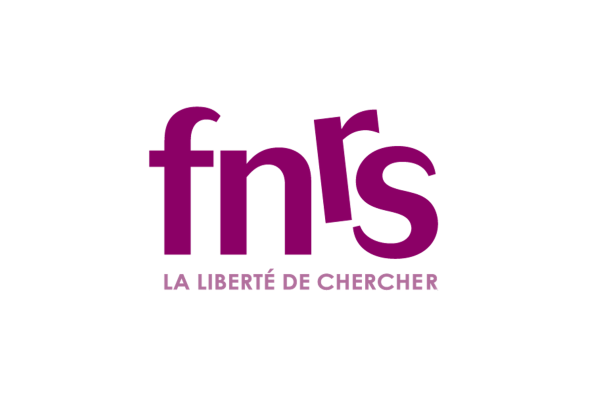
This article is taken from the "Impact" section of Omalius magazine #35 (December 2024).

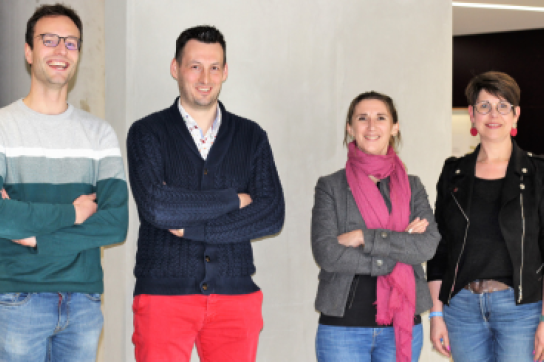
Career prospects for mathematicians
Career prospects for mathematicians
Mathematics graduates are rare. And yet, many employers are looking for them: banks, insurance companies, consultancy firms, private and university research centres, schools... To help its students identify the possibilities open to them, the Mathematics Department invited them to meet four alumni who are currently working as business analysts, data analysts, teachers, risk directors and actuary.
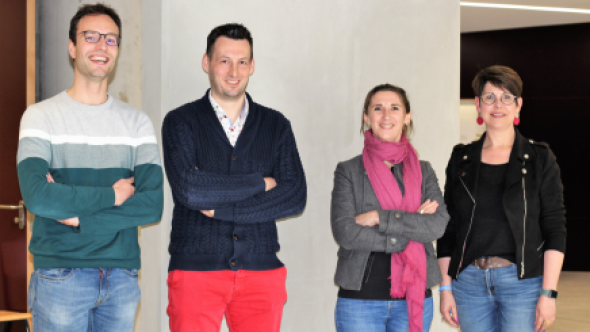
Une fois diplômé, Florian Baetmans a rapidement trouvé un poste de business analyst dans le secteur des assurances. Chargé de faire le lien entre les utilisateurs de logiciels et les développeurs, son parcours l’a amené à travailler pour diverses entreprises, à voyager régulièrement en Tunisie, mais aussi à se lancer comme indépendant. Aujourd’hui Senior Business Analyst chez Thewave, il n’hésite pas à dire aux étudiants« Vous avez choisi des études en or. Vous avez des têtes bien faites et les employeurs recherchent vos compétences. » Ils apprécient en effet la capacité des mathématiciens à analyser, à comprendre et à résoudre les problématiques de manière très pragmatique.
Bastien Delaunois a débuté sa carrière chez Orange comme Business insight analyst au sein de l’équipe BI pour ensuite passer dans le département Business. Il aime notamment le contact avec les clients et avec les partenaires qui lui permettent d’adopter une approche concrète, appliquée, dans son travail d’analyse. Aujourd’hui, il est data analyst et fait aussi de la data quality pour par exemple évaluer la fiabilité des données dans le cadre d’un transfert d’un système à un autre. « Pour beaucoup, cette matière paraît très complexe. On devient donc une référence à leurs yeux », souligne Bastien. Il insiste également sur l’importance de l’approche scientifique qui invite les mathématiciens à remettre en question des résultats et à les analyser de manière critique.
Ma formation m’aide beaucoup, notamment pour le côté persévérant du mathématicien.
Virginie Gekiere a passé son agrégation en 2e licence. Depuis 28 ans, elle travaille à l’Institut Saint-Charles Dottignies-Luingne, d’abord en tant que professeure, ensuite comme directrice adjointe. D’emblée, elle alerte l’auditoire : « Je vous assure qu’on cherche des profs de math. C’est vraiment une quête très difficile en ce moment ». Depuis 2,5 ans, elle occupe une fonction de direction au sein de l’école. « Ma formation m’aide beaucoup, notamment pour le côté persévérant du mathématicien qui a envie d’aller au fond des choses, qui sait analyser, prendre le temps de poser la situation de départ, d’évaluer les moyens disponibles pour arriver à une solution, qui va chercher pendant des heures, des jours et qui va ajuster si le résultat ne convient pas. Comme chef d’établissement, on assume des fonctions très différentes : gérer les ressources humaines, le financier, les bâtiments, la communication, la pédagogie, le numérique, les élèves, et les parents. ». Elle ajoute « Si vous n’aimez pas le contact avec l’autre ni le travail collaboratif, il ne faut pas aller dans l’enseignement. Si vous êtes individualiste, vous n’y serez pas heureux. » À la question d’un étudiant qui lui demande s’ils ont vraiment besoin d’un master en mathématique pour enseigner dans le secondaire supérieur, elle répond « oui » sans hésitation. Et ce, pour deux raisons : le master permet de mieux expliquer les concepts parce qu’ils ont été étudiés en profondeur, et d’acquérir des compétences pédagogiques nécessaires. « Ce n’est pas parce qu’on a fait les maths, qu’on arrive à gérer une classe d’ados » insiste-telle !
Vous avez une grande capacité à travailler en autonomie, mais aussi en groupe.
Après avoir obtenu une licence en mathématiques, Noémie Laloux a poursuivi sa formation en actuariat. D’emblée, elle précise que les mathématiques nécessaires en actuariat sont « très concrètes mais d'un niveau de complexité nettement moins élevé que ce que vous voyez en analyse ou en algèbre ». Elle a débuté sa carrière dans la consultance et dans le domaine des retraites. Ensuite, comme le métier de consultant ne correspondait plus à ses aspirations, elle est entrée dans une compagnie d’assurance, de type mutualiste, Contrassur. Elle a d’abord travaillé dans l'actuariat. Assez vite, elle a eu envie de sortir du côté répétitif de sa fonction. Au fur et à mesure, elle est devenue responsable du risque. Aujourd’hui en plus de l’analyse des risques elle a repris la direction de l’actuariat. Elle précise qu’elle n’utilise pas les mathématiques au même niveau de technicité et de complexité que ce qu’elle a appris lors de ses études. Mais sa formation poussée en mathématiques lui permet de comprendre, d’analyser, d’expliquer des choses compliquées de manière assez simple. Elle souligne également les atouts de l’UNamur : « Vous êtes très bien formés. Vous avez une grande capacité à travailler en autonomie, mais aussi en groupe. »
Les questions de l’auditoire étaient diverses et les témoignages éclairants. Au terme de la séance, les Alumni ont tous insisté sur le fait qu’il est inutile de s’entêter dans un métier ou un secteur, si on ne l'aime pas. Les mathématiques ouvrent en effet de nombreuses portes : l’informatique, les assurances, les banques, le secteur pharmaceutique, l’enseignement, la recherche privée ou universitaire, etc. Et, comme l’a expliqué Bastien Delaunois « Durant nos études, on apprend à apprendre. On arrive donc assez vite à se débrouiller dans beaucoup de domaines. »
Portrait d’Alumnus :

Two prestigious publications for our network dynamics researchers
Two prestigious publications for our network dynamics researchers
Maxime Lucas is an FNRS Research Fellow in the Department of Mathematics and a member of the naXys Institute. He works on complex systems within the "Network Dynamics" cluster headed by Professor Timoteo Carletti. He is co-author of two papers on complex systems, recently published in prestigious journals Nature Physics and Physical Reviews Letters.

Analysis of collective behavior in complex systems
The study of complex systems published in Physical Reviews Letters supports a growing trend that focuses more on analyzing the collective behavior of a system rather than discovering the underlying mechanisms of interaction.
When we observe a flock of starlings swirling through the sky in perfect coordination - a phenomenon known as murmuration - we witness the elegant interplay of individual actions creating collective behavior. In trying to understand these fascinating patterns, researchers can isolate simple rules based on an individual bird's field of view and the distance separating it from its neighbors, but there's always the question of whether the model actually captures the processes driving interactions between birds (Fig. 1).
This is a general problem in complex systems research, which comes down to distinguishing mechanisms (the rules governing interactions) from behaviors (the observable patterns that emerge).
Figure 1: In bird flocks, each bird chooses its movement according to the separation distance and flight orientation of its neighbors (left). These simple rules can produce complex patterns, such as starling "murmurations" (right). New research explores how mechanisms (individual rules) are linked to behaviors (collective patterns) in networks that represent complex systems.

Representative networks of interacting individuals, or nodes, are a good way to study mechanisms versus behaviors. Until now, researchers have focused on pairwise interactions, but many systems also include higher-order interactions between several nodes. The impact of these higher-order mechanisms on behavior has not been clearly established. Thomas Robiglio, from the Central European University in Vienna, and his colleagues, including Maxime Lucas (CR FNRS - UNamur) addressed this question. They considered networks with higher-order interactions and evaluated the resulting behaviors in terms of statistical dependencies between node values.
The researchers identified higher-order behavioral signatures which, unlike their pairwise counterparts, reveal the presence of higher-order mechanisms. Their findings open up new avenues for distinguishing mechanisms and behaviors when studying complex systems - a distinction that is crucial for the study of inference in network science, neuroscience, the social sciences and beyond.
This study is also the subject of a "Featured in Physics" and "Editor's suggestion" article, and a "commentary" article at the journal's request, available on their website in English in full.
Namur Institute for Complex Systems (naXys)
The naXys institute specializes in the analysis of complex systems, whether in astronomy and dynamic cosmology, mathematical biology, optimization in optics, economic complexity or the study of the stability and robustness of these systems.


UNamur researchers published in Nature Physics
UNamur researchers published in Nature Physics
Professor Timoteo Carletti of the University of Namur has just published in the prestigious journal Nature Physics in collaboration with Professor Ginestra Bianconi of Queen Mary University of London and eight other international researchers. This groundbreaking study could lead to the development of new AI algorithms, new ways of studying brain function, or breakthroughs in disciplines such as physics, climate science, finance and many others.

The study, entitled "Topology shapes dynamics of higher-order networks" proposes a theoretical framework specifically designed to understand complex higher-order networks where several agents interact at the same time and thus generalize networks with their interactions in pairs. More precisely, the study shows how topology shapes dynamics, how dynamics learns topology and how topology evolves dynamically.
The aim of this work is to introduce physicists, mathematicians, computer scientists and network scientists to this emerging research field, as well as to define future research challenges where discrete topology and nonlinear dynamics mix.
With the data in their possession, the researchers show that real-life complex systems such as the brain, chemical reactions and neural networks can be easily modeled as higher-order networks, characterized by multi-body connections indicating the fact that several elements of the system interact simultaneously.
This international team is convinced that the visibility of their work through this publication in Nature Physics will open the door to new collaborations with other disciplines that rely on network analysis to study real complex systems.
Kudos to the team for this publication!
Timoteo Carletti - Mini CV
After a Master's degree in physics (University of Florence, June 1995), Timoteo Carletti pursued his doctoral studies in Florence (Italy) and Paris (France) at IMCCE, finally defending his doctoral thesis in mathematics in February 2000.
He moved to Belgium in 2005, and was hired at the University of Namur as a lecturer, then as a professor (2008), and finally as a full professor (2011) in the Mathematics Department of the Faculty of Science. In 2010, he was one of the founders of the Namur Center for Complex Systems (now the Namur Institute for Complex Systems - naXys), which he headed until December 2014.
.
Better prediction of climate extremes
Better prediction of climate extremes
Statistics usually focus on anticipating events that fall within the norm. But what about rare events? They are dealt with by a branch of mathematics called extreme value theory, in which Anna Kiriliouk, lecturer in statistics at UNamur, is a specialist. Applied to the climate, this theory enables us to better predict extreme climatic events, at a time when these are multiplying due to climate change.

This article is taken from the "Impact" section of the December 2024 issue of Omalius magazine.
On the night of January 31, 1953, the North Sea suddenly rose by almost four meters, submerging parts of the Netherlands and Belgium. The disaster caused the death of over 2,500 people, as well as considerable damage. According to Anna Kiriliouk, lecturer in statistics at UNamur's Department of Mathematics and EMCP Faculty, this exceptional event truly marked "the beginning of the development of extreme value theory, with the development of the first extreme value construction project"
The Delta Plan, as it is called, is a system of dikes that protects the Netherlands against the risk of flooding, with these dikes overtopping once every 10,000 years. A rare danger, certainly, but not zero, which "could not have been calculated using conventional statistics, which are very poorly adapted to rare events", believes the mathematician.
While climate change is often discussed in terms of averages, such as rising temperatures and sea levels, it also has the consequence of increasing the frequency of extreme weather events, with significant repercussions for our societies. "In other words, the risk increases along with the concentration of greenhouse gases (GHGs) in the atmosphere", summarizes the researcher. "Thus, a flood calculated in 1953 to occur only every 10,000 years does not have the same significance as today. The latter could happen more frequently, for example every 1,000 years."
Attributing extreme events
While extreme weather events are on the increase, it's difficult in practice to attribute any particular flood or drought to climate change. With this in mind, Anna Kiriliouk has just been awarded an interdisciplinary research project,named EXALT, in collaboration with UCLouvain. "It involves both climatologists and statisticians, she reveals.

"This collaboration is very important, because answering this question of the attribution of extreme events can only be done through the development of a common language between our two disciplines, which currently operate separately. We have a lot to learn from each other"
In practice, the EXALT project will therefore calculate the probabilities of an extreme event occurring, and compare this probability with that of the same situation in a world where GHG emissions would not have increased. "Of course, we don't have real data from such a world", says Anna Kiriliouk. "We are therefore basing ourselves on alternative climate simulations, the quality of which we will moreover compare, with a focus on extreme events."
Divided into three working groups, the EXALT project will seek in particular to determine the role of climate change in the occurrence of floods, as well as heat waves and drought in Europe. And to do so as realistically as possible: "One of the things we want to incorporate into climate models concerns the dependency between data," explains Anna Kiriliouk. "For example, if a heat wave hits Namur, there's a good chance that the same temperatures will affect Louvain-La-Neuve. We therefore say that there is a strong spatial dependency between these two data. However, this dependence is probably not at all valid for rain, which is much more heterogeneous. By taking into account all these variables, both spatial and temporal, we hope to improve existing models."
A third working group will study much more distant areas, located in Antarctica. "Until 2016, the extent of the Antarctic ice pack was increasing, before abruptly decreasing", the researcher illuminates. "Or, according to the models, this event was considered almost impossible. But with one of EXALT's partners, we began to analyze the evolution of pack ice extent using extreme value theory. With the latter, this sudden drop was no longer so improbable. This gave us confidence in our approach, which is all the more important when the state of the pack ice has such a strong influence on other climate variables."
Compound events
This interaction between several climatic processes is, moreover, the subject of a second project just obtained by Anna Kiriliouk and funded by an FNRS Mandat d'Impulsion Scientifique. "The aim is to make it possible to study what we call compound events", explains the researcher. "During extreme climatic situations, we usually associate very high or low values simultaneously, such as a lack of rain and high temperature, resulting in an intense drought. But in the case of compound phenomena, we find that the combination of several variables, albeit in a moderate state, results in a severe and unusual event."
In 2017, for example, Hurricane Sandy, which struck the US coastline, is considered a compound event. While North Atlantic hurricanes usually dissipate in mid-ocean, this one coincided with onshore winds and a high tide, leading to massive flooding of New York and the surrounding area.
"In this project, we will therefore try to include more flexibility between the different variables, by introducing different degrees of dependence, the mathematician elaborates. "We're also going to try, as a second step, to group the dependencies together, in order to lighten the models, which become more and more complex as we add nuances to them. And once these models have been modified, we'll apply them to recent events to test their realism."
EXALT - ARC project (FWB)
Funded by the Wallonia-Brussels Federation (FWB), ARC projects are Concerted Research Action projects that aim to develop university or inter-university centers of excellence in basic research areas and, where possible, that carry out basic and applied research in an integrated way and aim to add economic and social value to research results.

Mandat d'impulsion scientifique (MIS) - FNRS
The aim of the funding granted is to support young permanent researchers wishing to develop a scientific unit within their academic institution in a promising field. This mandate has earned Anna Kiriliouk a fellowship from Namur Research College (NARC).

This article is taken from the "Impact" section of Omalius magazine #35 (December 2024).


Career prospects for mathematicians
Career prospects for mathematicians
Mathematics graduates are rare. And yet, many employers are looking for them: banks, insurance companies, consultancy firms, private and university research centres, schools... To help its students identify the possibilities open to them, the Mathematics Department invited them to meet four alumni who are currently working as business analysts, data analysts, teachers, risk directors and actuary.

Une fois diplômé, Florian Baetmans a rapidement trouvé un poste de business analyst dans le secteur des assurances. Chargé de faire le lien entre les utilisateurs de logiciels et les développeurs, son parcours l’a amené à travailler pour diverses entreprises, à voyager régulièrement en Tunisie, mais aussi à se lancer comme indépendant. Aujourd’hui Senior Business Analyst chez Thewave, il n’hésite pas à dire aux étudiants« Vous avez choisi des études en or. Vous avez des têtes bien faites et les employeurs recherchent vos compétences. » Ils apprécient en effet la capacité des mathématiciens à analyser, à comprendre et à résoudre les problématiques de manière très pragmatique.
Bastien Delaunois a débuté sa carrière chez Orange comme Business insight analyst au sein de l’équipe BI pour ensuite passer dans le département Business. Il aime notamment le contact avec les clients et avec les partenaires qui lui permettent d’adopter une approche concrète, appliquée, dans son travail d’analyse. Aujourd’hui, il est data analyst et fait aussi de la data quality pour par exemple évaluer la fiabilité des données dans le cadre d’un transfert d’un système à un autre. « Pour beaucoup, cette matière paraît très complexe. On devient donc une référence à leurs yeux », souligne Bastien. Il insiste également sur l’importance de l’approche scientifique qui invite les mathématiciens à remettre en question des résultats et à les analyser de manière critique.
Ma formation m’aide beaucoup, notamment pour le côté persévérant du mathématicien.
Virginie Gekiere a passé son agrégation en 2e licence. Depuis 28 ans, elle travaille à l’Institut Saint-Charles Dottignies-Luingne, d’abord en tant que professeure, ensuite comme directrice adjointe. D’emblée, elle alerte l’auditoire : « Je vous assure qu’on cherche des profs de math. C’est vraiment une quête très difficile en ce moment ». Depuis 2,5 ans, elle occupe une fonction de direction au sein de l’école. « Ma formation m’aide beaucoup, notamment pour le côté persévérant du mathématicien qui a envie d’aller au fond des choses, qui sait analyser, prendre le temps de poser la situation de départ, d’évaluer les moyens disponibles pour arriver à une solution, qui va chercher pendant des heures, des jours et qui va ajuster si le résultat ne convient pas. Comme chef d’établissement, on assume des fonctions très différentes : gérer les ressources humaines, le financier, les bâtiments, la communication, la pédagogie, le numérique, les élèves, et les parents. ». Elle ajoute « Si vous n’aimez pas le contact avec l’autre ni le travail collaboratif, il ne faut pas aller dans l’enseignement. Si vous êtes individualiste, vous n’y serez pas heureux. » À la question d’un étudiant qui lui demande s’ils ont vraiment besoin d’un master en mathématique pour enseigner dans le secondaire supérieur, elle répond « oui » sans hésitation. Et ce, pour deux raisons : le master permet de mieux expliquer les concepts parce qu’ils ont été étudiés en profondeur, et d’acquérir des compétences pédagogiques nécessaires. « Ce n’est pas parce qu’on a fait les maths, qu’on arrive à gérer une classe d’ados » insiste-telle !
Vous avez une grande capacité à travailler en autonomie, mais aussi en groupe.
Après avoir obtenu une licence en mathématiques, Noémie Laloux a poursuivi sa formation en actuariat. D’emblée, elle précise que les mathématiques nécessaires en actuariat sont « très concrètes mais d'un niveau de complexité nettement moins élevé que ce que vous voyez en analyse ou en algèbre ». Elle a débuté sa carrière dans la consultance et dans le domaine des retraites. Ensuite, comme le métier de consultant ne correspondait plus à ses aspirations, elle est entrée dans une compagnie d’assurance, de type mutualiste, Contrassur. Elle a d’abord travaillé dans l'actuariat. Assez vite, elle a eu envie de sortir du côté répétitif de sa fonction. Au fur et à mesure, elle est devenue responsable du risque. Aujourd’hui en plus de l’analyse des risques elle a repris la direction de l’actuariat. Elle précise qu’elle n’utilise pas les mathématiques au même niveau de technicité et de complexité que ce qu’elle a appris lors de ses études. Mais sa formation poussée en mathématiques lui permet de comprendre, d’analyser, d’expliquer des choses compliquées de manière assez simple. Elle souligne également les atouts de l’UNamur : « Vous êtes très bien formés. Vous avez une grande capacité à travailler en autonomie, mais aussi en groupe. »
Les questions de l’auditoire étaient diverses et les témoignages éclairants. Au terme de la séance, les Alumni ont tous insisté sur le fait qu’il est inutile de s’entêter dans un métier ou un secteur, si on ne l'aime pas. Les mathématiques ouvrent en effet de nombreuses portes : l’informatique, les assurances, les banques, le secteur pharmaceutique, l’enseignement, la recherche privée ou universitaire, etc. Et, comme l’a expliqué Bastien Delaunois « Durant nos études, on apprend à apprendre. On arrive donc assez vite à se débrouiller dans beaucoup de domaines. »
Portrait d’Alumnus :
Agenda
Preparatory courses
Top start for a revision period

A program for every discipline
During late August and early September, UNamur offers rheto students preparatory courses tailored to their future training.
These revision sessions are specially designed to support students in their transition to university. By reinforcing their foundations in the key subjects of their future discipline, they enable them to approach their first year with confidence.
These preparatory courses are also an excellent opportunity to discover the campus, meet future classmates and familiarize themselves with the learning methods specific to higher education.
Preparation for the medical entrance exam
For students wishing to begin studying medicine, two sessions are also organized according to a specific timetable to prepare for the entrance exam.
Academic year 2025-2026
Something for everyone
09:30 | Welcome ceremony for new students
11:00 | Back-to-school celebration at Saint-Aubain Cathedral (Place Saint-Aubain - 5000 Namur), followed by student welcome by the Cercles.
Official ceremony for the start of the academic year 2025-2026
Save the date!




